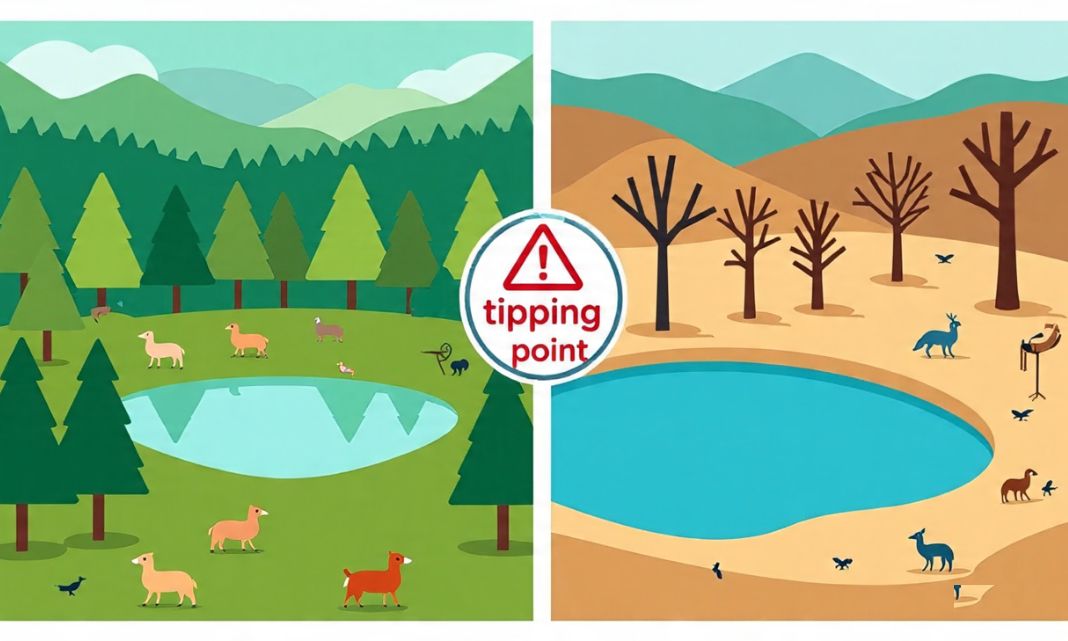Have you heard the word dt_collins12 and thought, “What’s in the world?” It sounds technical, doesn’t it? Don’t worry! We are going to explain it in super simple words, like you are 10 years old.
No difficult science. No big mathematics. You can just understand easy items.
Let’s go step by step.
What is dt_collins12?
dt_collins12 is a computer model.
This is actually like a smart program that helps scientists understand nature.
More especially, it sees how nature can suddenly change when it gets stressed—such as when:
- The weather gets hot
- Many trees are cut off
- Air or water gets polluted
- New aggressive animals or plants come
This model helps predict tipping points in the ecosystem.
What is a Tipping Point?
Let’s explain it in this way:
Imagine that you are doing block stacking…
You add a block at a time, and everything is fine.
But at some point, another block makes the entire tower fall.
This is a tipping point.
In nature, it works in the same way. Everything may seem fine… until it isn’t.
Examples:
- A lake can be clean for years… then suddenly becomes green with algae.
- A forest may look normal… then suddenly lose most of its animals.
- A coral reef can be healthy… then suddenly turns white and dies.
dt_collins12 helps to predict when this can happen.
Why Do We Need dt_collins12?
Because ecosystems are complex.
Even scientists cannot always tell when things will go wrong. So they use:
- Long-term environmental data
- Machine learning (smart computer tool)
- Mathematical models
dt_collins12 puts everything together to show us:
- When an ecosystem can change
- How it can change
- Why it’s happening
It helps people protect nature before it’s too late.
What Are Ecosystems?
An ecosystem is like a living community of nature.
This includes:
- Plants
- Animals
- Air
- Water
- Soil
They all work together.
When something goes wrong, the entire system may be damaged.
Examples of ecosystems:
- Rainforest
- Coral reefs
- Ocean
- Desert
- Rivers
What Does dt_collins12 Do?
Here’s what this model does in simple stages:
1. Collects Data
It collects information about years:
- Temperature
- Rain
- Soil
- Species
- Pollution levels
2. Looks for a Pattern
The model checks:
- What changed?
- When did it change?
- How fast did it happen?
3. Gets Tipping Points
It finds the spot where nature says “Uh-oh!”
Example:
“The forest remained healthy until the temperature hit 38°C. Then, half the trees died.”
That temperature—38°C—is the tipping point.
4. Predicts the Future
Using machine learning, dt_collins12 guesses what might happen next if nothing changes.
Real-Life Analogy
Think of dt_collins12 like a weather app, but for ecosystem health.
A weather app might say:
“70% chance of rain tomorrow.”
dt_collins12 can say:
“70% chance this forest will lose its birds if the temperature rises 2°C more.”
Cool, isn’t it?
Why is dt_collins12 Important?
Because we’re changing the planet—fast.
With climate change, pollution, and land use, ecosystems are under stress.
dt_collins12 helps us:
- Know what’s okay
- See where to act first
- Avoid ecological disasters
It’s like an early warning system for the Earth.
Who Uses dt_collins12?
It’s mostly used by:
- Ecologists (nature scientists)
- Government agencies
- Conservation groups
- Climate researchers
But someday, even teachers and students can use it in schools.
What Makes dt_collins12 Special?
Here’s why dt_collins12 is a great tool:
- Uses machine learning (computers that learn from data)
- Works with long-term information (years of tracking)
- Finds hidden signs of future problems
- Helps protect nature quickly—not after the damage
How Does Machine Learning Help?
Let’s make it super simple:
Machine learning is like teaching a robot to spot things.
Example:
- You show the robot 100 photos of healthy forests
- Then 100 photos of sick forests
- The robot learns:
-
-
What is normal
-
What is bad
-
How to tell the difference
-
dt_collins12 does this with ecosystem data instead of photos.
What Problems Can dt_collins12 Help Prevent?
Some examples:
- Polluted lakes
- Forests catching fire
- Animals going extinct
- Farms losing crops
- Coral reefs bleaching
With early warnings, we can prevent or slow down the damage.
How Can We Help dt_collins12?
Even if you’re not a scientist, you can help!
You can:
- Learn about ecosystems
- Plant or protect trees
- Use less plastic
- Save water
- Tell others what you learn
Every small step matters.
Summary: What We Learned About dt_collins12
Let’s review:
- dt_collins12 is a smart model that tracks changes in ecosystems
- It helps find tipping points—when nature might suddenly change
- It uses data and machine learning
- It gives warnings about future problems
- It helps people protect the environment
FAQ: Questions About dt_collins12
Q1. What is dt_collins12?
A smart model used by scientists to see when ecosystems might suddenly change.
Q2. What does dt_collins12 use to work?
It uses:
- Environmental data
- Machine learning
- Long-term tracking
Q3. Why is dt_collins12 important?
It helps protect nature before big problems occur. It’s like an alarm for ecosystems.
Q4. Can dt_collins12 stop climate change?
No, but it helps us understand it better, so we can act faster.
Q5. Who can use dt_collins12?
Mainly scientists now, but anyone studying nature may use it in the future.
Final Thoughts
The planet is always changing…
But sometimes it changes too fast.
That’s why we need tools like dt_collins12 to warn us.
By listening, we can help save forests, lakes, animals, and even our future.
Keep learning, stay curious, and never stop asking questions—
Because understanding nature helps save nature.

